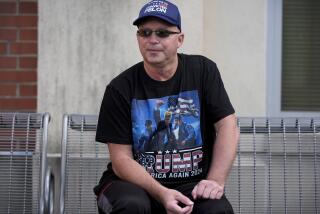Fund-Raisers’ Use of White House Database Reported
- Share via
WASHINGTON — The Clinton administration, acting at the direction of the president and first lady, created a massive computer data system with federal funds in 1994 to keep tabs on as many as 350,000 people, including large political donors, Democratic campaign workers and visitors to the White House.
Internal documents reveal that the White House issued guidelines and legal opinions advising that the system could be used only for official government purposes. But the White House staff frequently retrieved data on large political contributors and turned it over to the Democratic National Committee to help raise money for the president’s reelection, interviews show.
The use of the computer, dubbed “WhoDB” for White House Office Data Base, provides further indications that aspects of the Democratic Party’s $125-million fund-raising effort were carried out in the White House and that some of its components were based there.
Also, the records reflect the assortment of perquisites beyond private coffee klatches with the president that the administration made available for prospective donors: seats aboard Air Force One, personal notes from Clinton, lunch in the White House mess and invitations to watch a movie in the East Wing.
It is entirely legal and customary for the White House to gather information from a variety of sources to help the president in his “official” capacity. But federal laws prohibit the administration from providing such data to a nongovernment organization, particularly a political committee such as the Democratic Party, for partisan purposes.
White House spokesman Barry Toiv said that the computer system serves as an electronic social calendar by storing lists of people who have been invited to presidential events or received holiday cards from the first family.
“The database is not a tool for tracking contributors,” Toiv said. “Nobody outside the White House was given access to it.” He said that the program logging perks was developed for the computer but never actually used.
However, a former top Democratic official said in an interview that he and his staff routinely used WhoDB to identify likely candidates for increased donations. For example, he said, the staff found out how many White House invitations certain donors were receiving, so they could arrange more events for prospective contributors.
This began in 1995 when the party was striving to raise money early for Clinton’s reelection in the wake of the Republican landslide the year before.
“I started checking back with the White House just as a routine matter,” said Truman Arnold, a Texas oil executive who served at Clinton’s request as finance chairman of the DNC during most of 1995. “It didn’t seem to be very privileged to me. It was open to a lot of people.”
Experts in campaign finance said that the national committee’s use of the information stored in WhoDB raises questions about whether the administration went over the line in using government equipment and personnel for political purposes.
“This is a very sophisticated, state of the art information file that is of great use internally to the White House staff and the president,” said Herbert E. Alexander, a USC political science professor and director of the Citizens’ Research Foundation. “But using that file for political purposes with an outside agency like the DNC is beyond the law and ought to be the subject of an investigation.”
Since July, a House Government Reform and Oversight subcommittee has been investigating WhoDB. The subcommittee is at odds with the White House over the release of computer records and is threatening to issue subpoenas for more material.
Democratic officials said they were not able to confirm Wednesday whether the DNC had used the White House computer for fund-raising purposes. “We are looking at this internally right now,” said spokeswoman Amy Weiss Tobe.
Internal memos obtained by The Times reveal that the administration took steps to keep the White House database secret.
In a Jan. 26, 1994, memo marked “confidential” to the first lady and top presidential aide Bruce Lindsey, deputy assistant to the president Marsha Scott wrote that all WhoDB equipment and records were in a locked room in the Old Executive Office Building next door to the White House and that she had taken extra precautions to ensure that the project was not subject to disclosure under the federal Freedom of Information Act.
According to a report filed by “The WhoDB Team,” the president and first lady requested in late 1993 that the White House staff start a resource database that would track official correspondence by the president and certain White House employees. It would allow staff members to plan future events and meetings as well as to compile a list for holiday cards.
The White House provided the subcommittee with a count of 355,211 individuals listed in the system. Toiv, however, said that the system contains the names of about 200,000 people. They include members of Congress, mayors, governors, community leaders, business leaders and reporters. Private information such as addresses, home telephones, Social Security numbers and dates of birth also are included, in part to expedite clearance into the White House by the Secret Service.
Documents show descriptions entered in a “Political Participation” field include “DNC Latino 1000,” “Early Supporter--Financial,” “1992 General Election Fundraiser” and “DNC Trustee.” The latter designation identified party donors who gave more than $100,000 a year.
These labels, according to administration officials, were used to help identify the backgrounds of visitors invited to attend White House functions or meet with the president and others.
“To the extent there are contributors in there, the vast majority of them [have] no indications of how much they gave or when they gave,” Toiv said. “The database was not used in any way to solicit campaign contributions.”
Nor were WhoDB files used to select guests to be invited to the 103 coffee klatches at the White House in the last two years, Toiv said. “That would be an inappropriate use of the database.”
The WhoDB manual and memos from the White House legal counsel make clear that the database may be used only for “official purposes.” In July, then-White House Counsel Jack Quinn said in a memo that providing information to “any outside source, including any campaign committees, for unofficial purposes is an impermissible use” of the database.
However, people familiar with the system said that during the last two years DNC workers routinely used the database as a fund-raising tool to recruit prospective donors and to solicit large contributions.
Arnold, the former party finance chairman, said that he was given a fund-raising goal of $42 million when he joined the national committee in March 1995. Arnold said he focused on reconnecting the party with contributors who had given in 1992 but who had “fallen from the fold.”
To do this, Arnold said, party staff members tapped the White House computer base, usually calling for the information. Arnold said that the national committee occasionally dealt with Ann Stock, head of the White House social office. Stock could not be reached for comment.
“It was most helpful to us because we were looking to the disaffected,” Arnold said. “The database helped us to see who had been invited to what.”
In some cases, Arnold said, the party discovered through the computer that donors who had given $25,000 had received numerous invitations to the White House, while supporters who had given $100,000 or more received nothing.
Arnold said he saw to it that the national committee focused attention on big donors who had been ignored by showering them with invitations that included movies at the White House theater, state dinners, seats aboard Air Force One, White House coffees and rounds of golf with Clinton.
“This was the way we reconnected to people. . . . “ Arnold said. “And when you started having fund-raisers . . . they would be the first people to show up and work for you.”
However, Toiv said, the computer was not used to aid fund-raising. “That is not the way it was used,” he said. “The DNC would only be calling in response to the White House wanting to know what names they would want to submit to an official event.”
Rep. David M. McIntosh (R-Ind.), who is leading the House investigation into the database, said it is evident that the White House was doing more than organizing social events and planning holiday greeting cards.
“It looks like the Democrats set up their donor-tracking software at the White House rather than the DNC,” he said. “We have to get to the bottom of this.”
More to Read
Get the L.A. Times Politics newsletter
Deeply reported insights into legislation, politics and policy from Sacramento, Washington and beyond. In your inbox twice per week.
You may occasionally receive promotional content from the Los Angeles Times.










